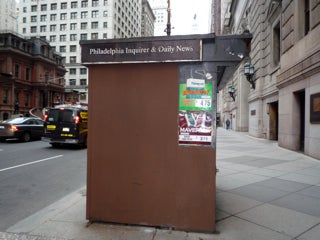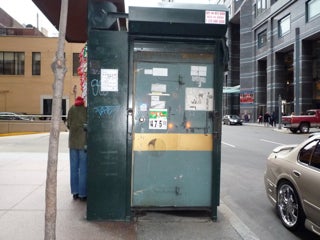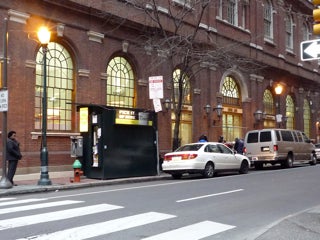News flash: Flashy newsstands to be debated

S.C.R.U.B. produced this simulation of an existing newsstand in the University City area to demonstrate what the backs of newsstands – facing the street – would look like under the new sign regulations. The president of the Newsstand Association of Philadelphia says the image is a misrepresentation. Currently, only signs for newspapers, magazines and the Pennsylvania Lottery are allowed, on a limited area of the stand.
May 6, 2009
By Thomas J. Walsh
For PlanPhilly
Center City newsstands could soon be calling much more attention to themselves, with legislation about to be enacted that will allow for signs that are larger – in number and in size, including streaming video and more illumination – along with a significant increase in the types of acceptable ads.
Philadelphia City Council will consider an amendment to the city code on outdoor signage Thursday morning. It was introduced by First District City Councilman Frank DiCicco earlier this year.
Newsstand owners are now limited to signs that promote newspapers, magazines and Pennsylvania Lottery products, though the posting of illegal ads for cigarettes or other small items is rarely enforced. The amendment would allow owners to install advertising for almost any kind of product or business, regardless of whether the newsstand owner sells what is being advertised.
Mary Tracy, executive director of SCRUB (Society Created to Reduce Urban Blight), says the amendment, which has received scant attention from neighborhood groups, “threatens the regulatory framework that has protected our public spaces from the proliferation of outdoor advertising for over 20 years.”
“Streaming video monitors concern me,” Tracy said. “That is something that is not really allowed anywhere else. But the huge billboard on the back of the newsstand – that’s what really bothers me.”
Under the amendment, the total area for the street-side ads would increase to seven feet wide by four feet high (more of a large poster than a billboard), all of which may be illuminated, presumably from within or by small exterior lighting. Ads on the sides of newsstands would be 18 inches wide and three feet high.
Newsstands would be further illuminated by electronically generated bands across the back (the street side) of newsstands that could be six inches in height – perhaps for a “news crawl” or some sort of rotating video display.
Critics of the bill say it does not spell out in detail exactly what would be allowed.
Newsstand Association of Philadelphia (NAP) President John Rocco told City Council in March that his members’ business has been significantly impacted by the rapidly declining fortunes of the newspaper industry and the uptick in the cigarette tax.
“Just seven, eight years ago, if a newsstand owner was selling, let’s say, 200 papers a day, he’s down to 50 now,” Rocco said. “That’s a big drop in seven or eight years. And I’m talking about the Daily News and The Inquirer. Our cigarette sales have fallen particularly in the last couple of weeks.
“Basically, our sales are flat, we’re down. And this bill, if it was passed, would help keep a lot of people above water, keep a lot of people at their newsstands. If we don’t get this sort of help, I don’t foresee as many newsstands as you see now – five, six, seven years from now. So this bill would help keep us keep afloat.”
Tracy said that DiCicco told her that he would not seek passage out of Council’s Committee on Streets and Services before amendments were made. “But [they said], ‘Let’s vote now, and if we have to amend it, we’ll amend it later,’ which is not the way it is supposed to work,” she said.
Brian Abernathy, DiCicco’s director of policy and public affairs, told Tracy that the councilman will ask for a final vote on the bill on May 14th.
The money side
Aesthetic concerns aside, the bill means a great deal more revenue could be coming to newsstands owners. Tracy, who says she has no problem with newsstands as they are intended, claims that is money that will take away from ad revenue the city receives for bus stop shelters and other municipal property where advertising is allowed, and will also detract from SEPTA’s income.
Late Wednesday afternoon, Rocco told PlanPhilly, “This extra added income will help us, but nobody is going to get rich off this. Right now we can use anything possible.”
In testimony before Council on March 24, Steve Buckley, the director of policy and planning for Deputy Mayor for Transportation Rina Cutler, said that “the increase in the amount of signage, coupled with permitting commercial advertising, will significantly enhance the value of the newsstand.”
While he said the Nutter administration recognizes challenges faced by small businesses during the current economic crisis, the administration “does not support this legislation in its current form,” Buckley said. “Important public policy questions are raised when considering new forms of advertising in the right-of-way, including on newsstands.”
Backers of the bill, including City Councilman Bill Greenlee, along with NAP, are concerned that the city is trying to take total control of the newsstands from the current operators. Critics of the Newsstand Association say its members are not bound by normal zoning laws and occupy prime Center City real estate, essentially rent-free.
Saying newsstands are “an important piece of the streetscape,” Buckley said he and Cutler want newsstands included in a comprehensive street-furniture program that is in the works.
That would assure a few things, he said, including “an esthetically distinctive design that complements other street-furniture features, which may include bus shelters, furniture, city information panels, and newspaper corrals.” If included in the street-furniture re-do, owners would be “guaranteed a maintenance program” to keep newsstands in good repair and graffiti-free.
To Tracy’s point about ad money for the city, the administration is in agreement, and Buckley told Council that the city could be provided with “considerable advertising revenue” that would support the street-furniture program. In New York City and other cities, Buckley said that “newsstand advertising typically contributes 25 percent of total advertising revenue in large-city street-furniture programs.”
Rocco, at the same March hearing, said newsstand operators ought not to be included in the category of mere street-furniture. He said new revenue from the ads would generate $25,000 to $30,000 in taxes for the city.
Attorney Joseph Beller, representing NAP, answering several Council members’ questions about the conformity and uniformity of newsstands, said, “Some years ago, you may remember, they were all different colors, different shapes, some were wood, some were tin.
“To this business of everybody being under one umbrella in street-furniture,” Beller said, “This is already been accomplished in a partnership with City Council and the newsstand operators. Those stands have been built one-by-one, and they’ve had to lend each other money very often, and you’re talking about close to $20,000 for each of those stands. And they are much prettier and they are much nicer. … So you have your uniformity, you have your conformity, you have your check and balance each and every year.”
A request-for-proposals for the comprehensive street-furniture program is to be issued by the Transportation Department by the end of 2009 for implementation in 2010. It will include a design competition and be preceded by public meetings.
The difference two years makes

Ironically, Nutter’s election was a cause for celebration among the members of the Newsstand Association. In May 2007, just after Nutter’s Democratic primary victory, a letter to membership, signed simply as “NAP,” championed Nutter as an agent of change and thus “the real possibility of a new attitude and appreciation for newsstands in our city.”
The letter stated: “If Mr. Nutter is elected as mayor in November, we will have for the first time, in our 14 years of existence, a friend in the mayor’s office. This is a major achievement for your association and it will surely help us as we move forward in the coming years.”
NAP represents 89 of the city’s 120 newsstand owners. While Rocco still chafes at the idea of being grouped into the category of “street furniture,” he said that NAP is due to meet with Transportation Department representatives next week, and will try to work together on streetscape improvements. “We have literally transformed the streetscape without city revenue – we did this all on our own and we continue to do it.”
Center City District President Paul Levy also testified at the March hearing, saying the CCD is not in principle opposed to the new advertising rules, but that he has some significant reservations. They include the expediency of graffiti removal, that the bill does not require operators to upgrade their newsstands, and that it does not address how the proposal would fit into any comprehensive approach to Center City design standards.
Again, Rocco said that since that hearing, his group has met with the CCD. “We were able to come to an agreement,” he said.
Rocco said that he has also worked in the past with George Claflen, of the Design Advocacy Group, to better unify his members’ newsstands, and to make them more attractive.
Licenses

Dimensions of newsstands, mandated by city code, are not exceed four feet in width, ten feet in length or nine feet in height.
Newsstand licenses are currently $250 for two years. The amendment to be heard Thursday would also increase this fee to $350 for two years, an amount Tracy considers still laughably low. Locations of newsstands are approved by the city’s Streets Department.
The amendment would also allow for graphic, non-illuminated logos on security gates that identify “the owner or sponsor” of the newsstand. The proposed design would have to be submitted to the Art Commission for approval.
Video monitors (assuming no more than one per newsstand) can be no larger than 24 inches wide, and must be “on the sidewalk side” of the newsstand.
Ads may not extend more than four inches from the facade of the newsstand, and must not “interfere with the minimum pedestrian right-of-way required.”
Contact the reporter at thomaswalsh1@gmail.com.
ON THE WEB:
Newsstand Association of Philadelphia (NAP): http://newsstandsofphilly.com/
NAP’s MySpace page: http://www.myspace.com/newsstandsofphilly
SCRUB: http://www.urbanblight.org/
March 24, 2009 Committee on Streets and Services transcript: http://www.urbanblight.org/Issues/Newstands/20090324_StreetsServicesTranscript.pdf
WHYY is your source for fact-based, in-depth journalism and information. As a nonprofit organization, we rely on financial support from readers like you. Please give today.





